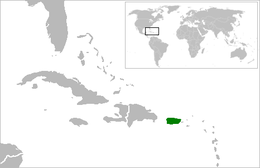Puerto Ricans in World War I
| Puerto Ricans in World War I | |||||||
|---|---|---|---|---|---|---|---|
|
| |||||||
| |||||||
Puerto Ricans and people of Puerto Rican descent have participated as members of the United States Armed Forces in every conflict in which the United States has been involved since World War I. One of the consequences of the Spanish-American War was that Puerto Rico was annexed by the United States in accordance to the terms of the Treaty of Paris of 1898, ratified on December 10, 1898. On January 15, 1899, the military government changed the name of Puerto Rico to Porto Rico (On May 17, 1932, U.S. Congress changed the name back to "Puerto Rico").[1] On March 21, 1915, the first shots by the United States in World War I were fired by the Porto Rico Regiment of Infantry from El Morro Castle at a German ship in San Juan Bay.[2] U.S. Citizenship was imposed upon Puerto Ricans as a result of the 1917 Jones-Shafroth Act (the Puerto Rican House of Delegates rejected US citizenship) and were expected to serve in the military.[3] Puerto Ricans who resided in the island were assigned to the "Porto Rico Provisional Regiment of Infantry," organized on June 30, 1901. The United States implemented the policy of military segregated units in Puerto Rico. Puerto Ricans of African descent where assigned to units made up only of blacks, such as the 375th Regiment.[4] Those who resided in the mainland served in regular units of one of the following branches of the United States military, the United States Marine Corps, Army or the Navy. As such, they were assigned to regular military units; however, Puerto Ricans of African descent were assigned to segregated all-black units and were subject to the discrimination which was rampant in the U.S. in those days.[5]
It is estimated that 236,000 Puerto Ricans in the island registered for the World War I draft and that 18,000 served in the war.[6] It is, however, impossible to determine the exact number of Puerto Ricans who resided in the United States mainland served and perished in the war because the War Department did not keep statistics in regard to the ethnicity of its members.[7]
Puerto Rican military service
Puerto Ricans fought and defended their homeland against attacks from the Caribs and pirates. They fought against the invasions of foreign countries and defeated the British, French, and Dutch in doing so.[8] They fought alongside General Bernardo de Gálvez during the American Revolutionary War in the battles of Baton Rouge, Mobile, Pensacola and St. Louis,[9][10] and in Europe against the forces of Napoleon Bonaparte at the Siege of Saragossa.[11]
In the 19th Century, Puerto Ricans fought against the Spanish Empire. They fought for Mexico's independence and in the Latin American revolutions alongside Simón Bolívar.[11] In Puerto Rico they revolted against Spanish rule and fought for Puerto Rico's independence in "El Grito de Lares" and in the "Intentona de Yauco."[12] They also fought for Cuba's independence in the Ten Years' War alongside General Máximo Gómez[13] and as members of the Cuban Liberation Army alongside Jose Marti.[14] At the end of the 19th century, Puerto Ricans fought alongside their Spanish counterparts in the Spanish-American War against the United States in the Battle of San Juan Hill in Cuba and in Puerto Rico when the American military forces invaded the island in what is known as the Puerto Rican Campaign[15] and against the "Tagalos" during the Philippine Revolution.[16]
The Porto Rico Regiment
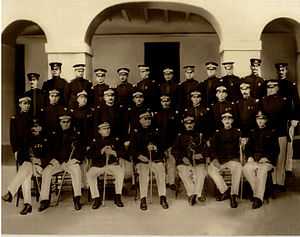
Puerto Rico became a U.S. Territory in accordance to the 1898 Treaty of Paris which ended the Spanish-American War. The United States appointed a military governor and soon the United States Army established itself in San Juan. The Army Appropriation Bill created by an Act of Congress on March 2, 1889 authorized the creation of the first body of native troops in Puerto Rico. On June 30, 1901, the "Porto Rico Provisional Regiment of Infantry" was organized. On July 1, 1901, the United States Senate passed a Bill which would require a strict mental and physical examination for those who wanted to join the Regiment. It also approved the recruitment of native Puerto Rican civilians to be appointed the grade of Second Lieutenants for a term of four years if they passed the required tests.[17] An Act of Congress, approved on May 27, 1908, reorganized the regiment as part of the "regular" Army. Since the native Puerto Rican officers where Puerto Rican citizens and not citizens of the United States, they were required to undergo a new physical examination to determine their fitness for commissions in the Regular Army and to take an oath of U.S. citizenship with their new officers oath.[18]
Camp Las Casas
There were many military installations in Puerto Rico, however Camp Las Casas played an instrumental role in preparing the native Puerto Ricans for the military. On January 30, 1908, the "Porto Rico Regiment of Infantry" was stationed at Las Casas Camp in Santurce a section of San Juan in what is now El Residencial Las Casas, a public housing complex. Camp Las Casas served as the main training camp for the Puerto Rican soldiers prior to World War I, the majority of the men trained in this facility were assigned to the "Porto Rico Regiment of Infantry." Puerto Ricans were unaccustomed to the racial segregation policies of the United States which were also implemented in Puerto Rico and often refused to designate themselves as "white" or "black". Such was the case of Antonio Guzman who at first was assigned to a white regiment only to be reassigned to a black regiment at Camp Las Casas. He requested a hearing and argued his case to no avail.[19] Captain Luis R. Esteves, who on June 19, 1915, became the first Puerto Rican to graduate from the United States Military Academy (West Point),[20] organized the 23rd Battalion which was composed of Puerto Ricans. Esteves served as instructor at the Officers' Training Camps that were established soon afterwards. He was instructor or commander of three of these camps, which produced all the officers who would lead the more than 20,000 men trained in Puerto Rico during World War I.

Marine aviation was fairly new, it came into existence on May 22, 1912, and the first major expansion of the Marine Corps' air component, of which Puerto Rico played a major rule, came with America's entrance into World War I. On January 6, 1914, First Lieutenant Bernard L. Smith established the Marine Section of the Navy Flying School in the island municipal Culebra.[21] As the number of Marine Aviators grew so did the avid desire to separate from Naval Aviation.[22] By doing so, the Marine Aviation was designated as separate from the United States Naval Aviation. The creation of a "Marine Corps Aviation Company in Puerto Rico consisted of 10 officers and 40 enlisted men.[23]
In addition several local militia units called "Home Guard" units were organized in various cities and towns to defend and maintain domestic order in the island. Virgil R. Miller, a native of San German, Puerto Rico, who in World War II served as the Regimental Commander of the highly decorated 442d Regimental Combat Team, served in the San Juan unit of the Puerto Rico Home Guard;[24] 2nd Lt. Pedro Albizu Campos organized the Ponce unit of the Home Guard.
"The Odenwald incident", 1915 – USA's first shot fired in World War I
Lt. Teófilo Marxuach's unit of the Puerto Rico Regiment of Infantry was stationed at El Morro Castle, (then an Army base called Fort Brooke) at San Juan Bay. The United States tried to remain neutral when World War I broke out in August 1914. However Washington insisted on its neutral right to send ships without them being attacked by German U-boats. The American ships carried food and raw materials to Britain. On March 21, 1915, Lt. Marxuach was the officer of the day at El Morro Castle. The Odenwald, built in 1903 (not to be confused with the German World War II war ship which carried the same name), was an armed German supply ship which tried to force its way out of the San Juan Bay and deliver supplies to the German U-boats waiting in the Atlantic Ocean. Lt. Marxuach gave the order to open fire on the ship from the walls of the fort. Sergeant Encarnacion Correa then manned a machine gun and fired warning shots with little effect.[18] Marxuach fired a shot from a cannon located at the Santa Rosa battery of "El Morro" fort, in what is considered to be the first shot of World War I fired by the regular armed forces of the United States against any ship flying the colors of the Central Powers,[25] forcing the Odenwald to stop and to return to port where its supplies were confiscated. The shots ordered by Lt. Marxuach were the first fired by the United States in World War I.[2]
International protest
.jpg)
Marxuach's actions became an international incident when the German Government accused the United States Government of the holding the Odenwald illegally against its will without firing the customary warning shot as required by international law. The United States Government responded that the official report of the United States War Department made by the commander of the fortress of El Morro Castle, Lt. Col. Burnham, made it clear that only warning shots were made and that none were aimed at the Odenwald.[2] Eventually, the Odenwald was refitted and renamed SS Newport by the U.S. Government and assigned to the U.S. Shipping Board, where it served until 1924 when it was retired.[26] In 1917 the Germans resumed submarine attacks, knowing that it would lead to America's entry into the war.
The United States officially declares war
On April 6, 1917, the United States Congress declared war on Germany. By May 3, the Regiment was transferred to the regular Army and recruited 1,969 men and the 295th, 296, 373rd, 374th and 375th regiments of Puerto Rico were created. The United States also applied their military segregation policies to the native Puerto Ricans. Puerto Ricans of African descent were assigned to all black units such as the 375th Regiment.[4] Puerto Ricans were to be sent to North Carolina to train for deployment overseas, however Senators from the southeastern states opposed and foiled these plans, citing that Puerto Ricans would be a problem to the laws and customs of the racist Jim Crow policies. Southern politicians were alarmed of the idea of having armed African-Americans in the south and believed that Puerto Ricans of mixed race, who did not understand their racial policies, would only add to their problems.[19] On May 17, the Porto Rico Regiment of Infantry was sent to guard the Panama Canal in defense of the Panama Canal Zone and other vital military installations while the other Puerto Rican regiments guarded Puerto Rico.

Puerto Ricans became U.S. citizens as a result of the 1917 Jones-Shafroth Act and two months later, when Congress passed the Selective Service Act, conscription was extended to the island. Those who were eligible, with the exception of women, were expected to serve in the military. About 20,000 Puerto Ricans were drafted during World War I.[27]
On November 1917, the first military draft (conscription) lottery in Puerto Rico was held in the island's capital, San Juan. The first draft number pick was made by Diana Yager, the daughter of the U.S. appointed governor of Puerto Rico Arthur Yager. The number she picked was 1435 and it belonged to San Juan native Eustaquio Correa. Thus, Correa became the first Puerto Rican to be "drafted" into the Armed Forces of the United States.[28] It is estimated that 236,000 Puerto Ricans in the island registered for the World War I draft and that 18,000 served in the war.[6] Prior to the Jones-Shafroth Act, Puerto Ricans in the mainland United States as all other non-citizens, who were permanent residents were required to register with the Selective Service System by law and could be drafted.[29]
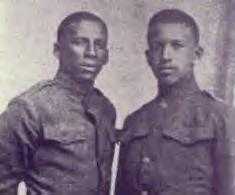
In New York, many Puerto Ricans of African descent joined the 369th Infantry Regiment which was mostly composed of Afro-Americans. They were not allowed to fight alongside their white counterparts; however, they were permitted to fight as members of a French unit in French uniforms. They fought along the Western Front in France, and their reputation earned them the nickname of "the Harlem Hell Fighters" by the Germans. Among them was Rafael Hernández Marín, one of Puerto Rico's greatest music composer and his brother Jesus. In 1917, Rafael Hernández was working as a musician in North Carolina, when the United States entered World War I. The Jazz bandleader James Reese Europe recruited brothers Rafael and Jesús Hernández, and 16 more Puerto Ricans to join the United States Army's Harlem Hell fighters musical band, the Orchestra Europe. The Hernández brothers enlisted and were assigned to the U.S. 369th Infantry Regiment (formerly known as the 15th Infantry Regiment, New York National Guard, created in New York City June 2, 1913). The "The Harlem Hell Fighters", as they were known by the Germans, served in France.[30] Hernandez toured Europe with the Orchestra Europe. The 369th was awarded Croix de guerre by France for battlefield gallantry.[30]
Pedro Albizu Campos was a Puerto Rican who volunteered in the United States Infantry. Albizu was commissioned a Second Lieutenant in the Army Reserves and sent to the City of Ponce where he organized the town's Home Guard. He was called to serve in the regular Army and sent to Camp Las Casas for further training. Upon completing the training, he was assigned to the 375th Infantry Regiment. The 375th was a regiment of black Puerto Ricans who were trained by non-Puerto Rican officers for overseas deployment, but the war ended before it could join the fight in Europe.[4] Albizu was honorably discharged from the Army in 1919, with the rank of First Lieutenant. During the time that he served he was exposed to the racism of the day which left a mark in his beliefs towards the relationship of Puerto Ricans and the United States, thus becoming a leading advocate for Puerto Rican independence.[18][31] Another Puerto Rican of African descent who was sent to Camp Las Casas was Nero Chen. Chen, a.k.a. "El Negro," was Puerto Rico's first professional boxer to gain international recognition and served as a boxing instructor to the servicemen at the camp.[32]
The sinking of the SS Carolina
On June 2, 1918, the SM U-151, the first German U-boat to operate in U.S. territory in World War I, sank six ships and damaged two others off the coast of New Jersey in the space of a few hours in what is known by historians as "Black Sunday".[33]
Among the ships sunk by torpedo was the SS Carolina, a Puerto Rican passenger vessel.[34] Prior to the sinking, Captain Heinrich von Nostitz, the U-boat commander, issued a warning as to his intentions. Captain T.R. Barbour of the SS Caroliona then gave the order to abandon ship. There were no casualties amongst the 217 passengers aboard the vessel, mostly citizens of Puerto Rico, including men from the Porto Rico Regiment of Infantry, when it was sunk.[34]
The SS Carolina was a cargo ship when it was purchased in 1905, by Juan Ceballos, the owner of the Porto Rico Line (later renamed New York & Porto Rico Steamship Co.). The company, which operated from 1885 to 1949, had a regular service route from Puerto Rico (Porto Rico) to Cuba involving several cargo vessels in the transportation of sugar.[35] In 1899, the company converted the SS Carolina into a passenger ship, providing services between San Juan, Puerto Rico, Havana, Cuba and New York City.[34]
Notable Puerto Ricans in combat
One Puerto Rican who distinguished himself in combat during World War I was Lieutenant Frederick Lois Riefkohl of the US Navy. On August 2, 1917, Riefkohl, a native of the town of Maunabo, became the first Puerto Rican to be awarded the Navy Cross. The Navy Cross, which is the second highest medal after the Medal of Honor, that can be awarded by the U.S. Navy, was awarded to Lt. Riefkohl for his actions in an engagement with an enemy submarine. Lt. Riefkohl, who was also the first Puerto Rican to graduate from the United States Naval Academy, served as a Rear Admiral in World War II.[36] His citation reads as follows:

| “ | The Navy Cross is awarded to Lieutenant Frederick L. Riefkohl, U.S. Navy, for distinguished service in the line of his profession as Commander of the Armed Guard of the U.S.S. Philadelphia, and in an engagement with an enemy submarine. On August 2, 1917, a periscope was sighted, and then a torpedo passed under the stern of the ship. A shot was fired, which struck close to the submarine, which then disappeared.[37] | ” |
Lieutenant Frederick L. Riefkohl's brother, Rudolph William Riefkohl also served. When the United States declared war on Germany in World War I, Riefkohl was commissioned a Second Lieutenant and assigned to the 63rd Heavy Artillery Regiment in France where he actievly participated in the Meuse-Argonne Offensive. According to the United States War Department, after the war he served as Captain of Coastal Artillery at the Letterman Army Medical Center in Presidio of San Francisco, in California (1918). He played an instrumental role in helping the people of Poland overcome the 1919 typhus epidemic.[38]
First Lieutenant Félix Rigau Carrera, from Sabana Grande, had received his pilot training in private pilot schools in Seattle, Washington and Minneapolis, Minnesota. After he earned his college degree in mechanical engineering, he joined the United States Army and was assigned to the Aviation Section, U.S. Signal Corps (the military aviation service of the United States Army from 1914 to 1918 and a direct ancestor of the United States Air Force). While in the Army, he traveled around the world and became acquainted with pilots of the era. He became the first Puerto Rican parachutist as a member of the Aviation Section of the U.S. Signal Corps, whose members were among the Army's first parachutist.[39] His stint in the Aviation Section, U.S. Signal Corps inspired him to go and attend various aviation schools upon his release from the military. He received his pilot training in private pilot schools in Seattle, Washington and Minneapolis, Minnesota.[40]
Puerto Ricans in non-combat roles
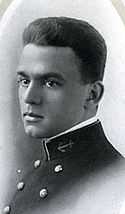
In 1918, a U.S. Employment Service Bulletin estimated that 75,000 unemployed laborers in Puerto Rico were available for work in the United States. The War Department agreed to transport workers to labor camps in the United States where they would be housed and fed while working on government construction contracts at defense plants and military bases located mostly in Louisiana, North and South Carolina and Georgia. In 1918, nearly 1,500 were sent to Arkansas to work in a picric acid factory. At least 176 died from influenza that fall.[41] Many of these work camps, however, subjected the new migrants to harsh conditions and even forced labor, which Rafael Marchán, a laborer, described in his 1918 deposition to the commissioner of Puerto Rico.[42]
By 1918, the Army realized that there was a shortage of physicians specializing in anesthesia, a low salary specialty required in the military operating rooms. Therefore, the Army reluctantly began hiring women physicians as civilian contract employees. The first Puerto Rican woman doctor to serve in the Army under contract was Dr. Dolores Piñero from San Juan. Even though she was not an active member of the military, Dr. Piñero entered service with the U.S. Army Medical Corps and was assigned to the San Juan base hospital where she worked as an anesthesiologist during the mornings and in the laboratory during the afternoons. Dr. Piñero and four male colleagues received orders to open a 400-bed hospital in Ponce, Puerto Rico, to care for the patients who had been infected with the influenza or as it was also known "the Swine Flu". The Swine Flu had swept through Army camps and training posts around the world, infecting one quarter of all soldiers and killing more than 55,000 American troops.[43]
Fernando E. Rodríguez Vargas, a dentist, joined the United States Army on August 16, 1917, and on September 14, was commissioned a First Lieutenant. Rodríguez Vargas was assigned to the Army Dental Reserve Corps and attended a course at the Medical Officer's Training Camp at Camp Greenleaf, Georgia before being sent overseas to the United Kingdom. On August 1919, he was reassigned to San Juan, Puerto Rico and served in Camp Las Casas.[44] On February 18, 1921, Rodriguez Vargas was sent to Washington, D.C. and assigned to the Army Dental Corps where he continued his investigations in the field of bacteriology.[44] Rodríguez Vargas was there as an educator and investigator of the bacteriological aspects of dental diseases. His research led him to discover the bacteria which causes dental caries. According to his investigations, three types of the Lactobacillus species, during the process of fermentation, are the causes of cavities.[45]
First Lieutenant Pedro Del Valle, the first Hispanic to reach the rank of Lieutenant General in the Marine Corps and who in World War II would play an instrumental role in seizures of Guadalcanal and Okinawa, commanded the Marine detachment on board the USS Texas (BB-35) in the North Atlantic during World War I. In 1919, he participated in the surrender of the German High Seas Fleet.[46]
Casualties
It is estimated that 18,000 Puerto Ricans from the Porto Rico Regiment served in the war and that 335 were wounded by the chemical gas experimentation which the United States conducted as part of its active chemical weapons program in Panama,[47] however neither the military nor the War Department of the United States kept statistics in regard to the total number of Puerto Ricans who served in the regular units of the Armed Forces (United States mainland forces), therefore, it is impossible to determine the exact number of Puerto Ricans who served and perished in World War I.[7] The "Monumento de la Recordación", which is a monument in San Juan, Puerto Rico dedicated to Puerto Rico's fallen military heroes, has the name of Luis Muñoz, inscribed on Panel 5, Line 1 as the only Puerto Rican casualty of the war, however there were more.
It may never be known who was the first Puerto Rican to die in that conflict. The municipality of Sabana Grande claims that Ángel Gregorio Martínez, one of its native sons, was the first to perish in that conflict, and the town named one of its main thoroughfares after him.[48] However, in Luis Fortuño Janeiro's "Album Histórico de Ponce (1692–1963)", the author claims that Juan Sanz from Ponce was the first one to perish in France during the WWI conflict.[49] Fortuño does not indicate if "the first one to perish in France" also implies "the first one to perish in the overall conflict", however, and there are no known plaques nor any kind of recognitions in Ponce that honor Juan Sanz.
The "American Battle Monuments Commission, World War I Honor Roll" has listed the following Puerto Ricans as casualties: Santiago Cintron Sergeant, U.S. Army; 6th Infantry Regiment, 5th Division; Died: October 29, 1918; Buried at: Plot B Row 34 Grave 9; Meuse-Argonne American Cemetery, Alberto J. Fernandes Civilian, U.S. Army; 127th Quartermaster Labor Company; Died: September 2, 1918; Buried at: Plot B Row 19 Grave 10; Suresnes American Cemetery; Suresnes, France and Alfredo A. Lima Civilian; Died: January 4, 1919; Buried at: Plot B Row 20 Grave 3; Suresnes American Cemetery; Suresnes, France.[50] Mario Cesar Miranda Cruz, from Arecibo died during combat in France and is buried in San Juan.[51]
Aftermath
Puerto Rican migration to the United States increased during and after World War I. May of those who went to the United States to work in the wartime factories or served in mainland military units made their homes in working-class communities that were mostly populated by Latinos.[52]
The Porto Rico Regiment returned to Puerto Rico in March 1919 and was renamed the 65th Infantry Regiment under the Reorganization Act of June 4, 1920.[53] The 65th went on to serve in World War II and the Korean War, where its members distinguished themselves in combat.
The need for a Puerto Rican National Guard unit became apparent to General Luis R. Esteves, who had served as instructor of Puerto Rican Officers for the Porto Rico Regiment of Infantry at Camp Las Casas in Puerto Rico. His request was met with the approval of the government and Puerto Rican Legislature. In 1919, the first regiment of the Puerto Rican National Guard was organized; Esteves became the first official Commandant of the Puerto Rican National Guard.[54][55]
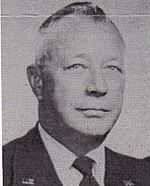
Some of the Puerto Ricans who served in World War I continued in the military and led distinguished careers, among them: Teófilo Marxuach, who retired in 1922 with the rank of Lieutenant Colonel, as a civilian worked as a civil engineer for the Department of Interior,[56] Luis R. Esteves, founded the Puerto Rico National Guard and retired in 1957 with the rank of Major General,[57] Virgil R. Miller, led the 442nd Regimental Combat Team in World War II, the most decorated unit in U.S. military history. After the Second World War he retired with the rank of Colonel,[58] Frederick Lois Riefkohl retired in 1947 with the rank of Rear Admiral,[59] His brother Rudolph W. Riefkohl' retired with the rank of Colonel and went on to become the mayor of the town of Surfside, Florida and Pedro del Valle, the only Hispanic to have retired from the Marine Corps with the rank of Lieutenant General, served as the Commanding General of the U.S. 1st Marine Division during World War II and played an instrumental role in the defeat of the Japanese forces in Okinawa.[60] Chief Gunner's Mate Joseph B. Aviles, Sr., who served in the United States Navy during the war, joined the United States Coast Guard in 1925, and was the first Hispanic to be promoted to Chief Petty Officer (March 27, 1943) in said branch of the military. Upon the outbreak of World War II, Aviles received a war-time promotion to Chief Warrant Officer (November 27, 1944), thus becoming the first Hispanic American to reach that level as well.[61]
Others led distinguished careers as civilians, among them the following: Dr. Dolores Piñero returned to her private practice in Río Piedras after her contract was terminated at the end of the war.,[43] Rafael Hernández Marín continued his career as a musician and is considered as the greatest composer of Puerto Rican music, Pedro Albizu Campos lawyer and distinguished political leader became the president of the Puerto Rican Nationalist Party from 1930 until his death and Félix Rigau Carrera also known as "El Águila de Sabana Grande" (The Eagle from Sabana Grande), who was the first Puerto Rican pilot and the first Puerto Rican pilot to fly on air mail carrying duties in Puerto Rico.[39]
See also
- Military history of Puerto Rico
- Camp Las Casas
- Puerto Ricans in World War II
- Puerto Ricans in the Vietnam War
- 65th Infantry Regiment in the Korean War
- Puerto Rican women in the military
- List of Puerto Rican military personnel
- List of Puerto Ricans
- Borinqueneers Congressional Gold Medal
References
- ↑ Dinwiddie 1899, p. 261
- ↑ 2.0 2.1 2.2 "CALLS ODENWALD AFFAIR AN ATTACK; Fired On Without Warning Shot, Germany Asserts, Contradicting San Juan Commander. SAYS SHE WAS UNDULY HELD Violated Clearance to Elude Enemy Cruisers That Had Been Warned She Was About to Sail.". New York Times. April 7, 1915. Retrieved August 24, 2009.
- ↑ Puerto Rico: Culture, Politics, and Identity; By Nancy Morris
- ↑ 4.0 4.1 4.2 Militias
- ↑ A CHRONOLOGY OF AFRICAN AMERICAN MILITARY SERVICE From WWI through WWII
- ↑ 6.0 6.1 Puerto Rico National Guard
- ↑ 7.0 7.1 "World War II By The Numbers". The National World War II Museum (New Orleans, LA). Archived from the original on 2007-04-26. Retrieved 2009-08-24.
- ↑ Historias de Puerto Rico by Paul G. Miller, (1947) pgs. 221–237
- ↑ Bernardo De Galvez: Hero of the American Revolution by Lorenzo G. Lafarelle, p. 57 Pub. Eakin Press and Marion Koogler McNay (1992), ISBN 0-89015-849-5
- ↑ Hector Díaz (March 16, 1996). "Maryland State Resolution on the Role Played by Hispanics In The Achievement of American Independence". Lasculturas.com. Retrieved August 24, 2009.
- ↑ 11.0 11.1 General Antonio Valero de Bernabe y su aventura de libertad: De Puerto Rico a San Sebastian by Lucas G. Castillo Lara (1991) Pub. Academia Nacional de Historia, ISBN 980-222-616-5
- ↑ Carlos Rovira (September 2005). "The birth of Puerto Rico’s fight for independence". S&L Magazine. Retrieved 2009-08-25.
- ↑ Marisabel Brás. "The changing of the guard: Puerto Rico in 1898". Hispanic Division. Library of Congress. Retrieved October 1, 2006.
- ↑ "Francisco Marin". Retrieved October 10, 2006.
- ↑ "1898 - Adjuntas en la Guerra Hispanoamericana" (in Spanish). Retrieved August 24, 2009.
- ↑ Miguel Hernández Torres. "Juan Alonso Zayas: Un héroe puertorriqueño desconocido" (in Spanish). Retrieved August 24, 2009.
- ↑ Puerto Rico's 65th Infantry
- ↑ 18.0 18.1 18.2 "Historia Militar de Puerto Rico"; by Héctor Andrés Negroni; pg. 370; ISBN 84-7888-138-7
- ↑ 19.0 19.1 "Reproducing Empire: Race, Sex, Science, and U.S. Imperialism in Puerto Rico"; by Laura Briggs; Page 62-62; Publisher: University of California Press; 1 edition (December 2, 2002); ISBN 0-520-23258-5; ISBN 978-0-520-23258-7
- ↑ "Hispanic-American Experience.". Fort Gordon Equal Opportunity Office, U.S. Army. Retrieved 2009-08-30.
Brigadier General Luis R. Esteves was the first Puerto Rican graduate of West Point and founder of the Puerto Rican National Guard.
- ↑ Condon, John Pomeroy (1993). "U.S. Marine Corps Aviation". 75th Year of Naval Aviation – Volume Five of a Commemorative Collection. History and Museums Division, Headquarters, U.S. Marine Corps. p. 3. Retrieved August 24, 2009.
- ↑ Corum (2003), p.23.
- ↑ Sherrod (1952), p.4–5.
- ↑ "Dr. Arthur Yager; Served as Governor of Puerto Rico for 8 years After 1913" (obituary)". New York Times. December 25, 1941. p. 25..
- ↑ "US Naval Institute Proceedings"; "A Breach of Neutrality"; by: Lt. Isaiah Olch, US Navy; Vol. 62; July - December 1936
- ↑ Newport News
- ↑ Politico: Puerto Ricans in World War I
- ↑ Eustaquio Correa
- ↑ "Can Non-Citizens Join the Military?", by: Jeremy Derfner
- ↑ 30.0 30.1 "Teaching With Documents: Photographs of the 369th Infantry and African Americans during World War I". Archives.gov. The U.S. National Archives and Records Administration. Retrieved 2009-08-30.
...Among the first regiments to arrive in France, and among the most highly decorated when it returned, was the 369th Infantry (formerly the 15th Regiment New York Guard), more gallantly known as the "Harlem Hellfighters." ... They were the first Americans awarded the Croix de Guerre, and they were not the only Harlem Hellfighters to win awards; 171 of its officers and men received individual medals and the unit received a Croix de Guerre for taking Sechault.
- ↑ Bridging the Atlantic. SUNY Press. 1996. ISBN 0-7914-2917-2. Retrieved August 24, 2009.
- ↑ "Pioneros Puertorriqueños en Nueva York;" by Joaquin Colon Lopez; pages: 229, 230; Publisher: Arte Publico Press (November 2001); ISBN 1-55885-335-9; ISBN 978-1-55885-335-5
- ↑ Down too long
- ↑ 34.0 34.1 34.2 New Jersey & Long Island New York Scuba Diving - New Jersey & Long Island New York
- ↑ La tragedia del vapor "SS Carolina" Por: Miguel Hernández Torres
- ↑ Riefkohl's Navy Cross Citation
- ↑ Riefkohl's Navy Cross citation
- ↑ Army Directory ... By United States War Dept, United States Adjutant-General's Office, United States
- ↑ 39.0 39.1 "Historia militar de Puerto Rico"; by Hector Andres Negroni (Author); Pages: 387; Publisher: Sociedad Estatal Quinto Centenario (1992); Language: Spanish; ISBN 84-7844-138-7; ISBN 978-84-7844-138-9
- ↑ "El Mundo"; "Fallece El Aguila - Fue Primer Boricua Manejo Avion en la Isla" (Spanish); by: Malen Rojas Daporte; October 20, 1954; Number 13,448
- ↑ Demirel, Evin. "Arkansas Mystery". Sync magazine. Retrieved 11 July 2012.
- ↑ Puerto Rican Laborers during World War I: The Deposition of Rafael Marchán
- ↑ 43.0 43.1 Mercedes Graf (Summer 2002). "With high hopes: women contract surgeons in World War I". Minerva: Quarterly Report on Women and the Military: 7. Retrieved August 24, 2009.
- ↑ 44.0 44.1 "Asuntos Historicos: Tributo Al Extinto Comandante Fernando E. Rodriguez"; by Dr. Jose Munoz Barait, Page 29
- ↑ San Francisco Cosmetic Dentistry
- ↑ "Lieutenant General Pedro A. Del Valle, USMC". History Division. United States Marine Corps. Retrieved August 24, 2009.
- ↑ Dept. of Defense; Number of Puerto Ricans serving in the U.S. Armed Forces during national emergencies
- ↑ Calle Ángel Gregorio Martínez
- ↑ Luis Fortuño Janeiro. "Album Histórico de Ponce (1692–1963)". Page 218. Ponce, Puerto Rico: Imprenta Fortuño. 496 pages. 1963.
- ↑ American Battle Monuments Commission
- ↑ Official website of Arecibo
- ↑ "The Puerto Rican Diaspora: Historical Perspectives"; by Carmen Teresa Whalen (Editor), Víctor Vazquez-Hernandez (Editor); Page 259; Publisher: Temple University Press (August 30, 2005); ISBN 1-59213-413-0; ISBN 978-1-59213-413-7
- ↑ 369th Regiment US Army color
- ↑ Puerto Rico's Fighting 65th U.S. Infantry: From San Juan to Chowon by W.W. Harris (2201), Pub. Presidio Press ISBN 0-89141-056-2.
- ↑ "Valerosos". Retrieved August 24, 2009.
- ↑ United States War Dept, United States Adjutant-General's Office, United States Record and pension office, United States Military secretary's dept (1918). Army Directory ... U. S. Govt. print. off.
- ↑ Hispanic Heritage Month
- ↑ "Po Valley Campaign". Japanese American Veterans Association. Retrieved August 24, 2009.
- ↑ "United States Naval Academy Cemetery of Columbarium" (PDF).
- ↑ Renda, Mary (2000). Taking Haiti: Military Occupation and the Culture of U.S. Imperialism, 1915-1940. University of North Carolina Press,. p. 61. ISBN 978-0-8078-4938-5. Retrieved August 24, 2009.
- ↑ site United States Coast Guard
Further reading
- Puertorriquenos Who Served With Guts, Glory, and Honor. Fighting to Defend a Nation Not Completely Their Own; by : Greg Boudonck; ISBN 978-1497421837
- Historia militar de Puerto Rico; by: Hector Andres Negroni; publisher=Sociedad Estatal Quinto Centenario (1992); ISBN 84-7844-138-7


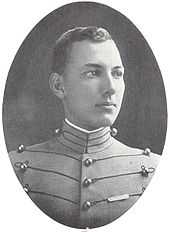
.jpg)


